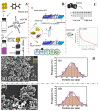MOF-Based Mycotoxin Nanosensors for Food Quality and Safety Assessment through Electrochemical and Optical Methods
- PMID: 36364341
- PMCID: PMC9654459
- DOI: 10.3390/molecules27217511
MOF-Based Mycotoxin Nanosensors for Food Quality and Safety Assessment through Electrochemical and Optical Methods
Abstract
Mycotoxins in food are hazardous for animal and human health, resulting in food waste and exacerbating the critical global food security situation. In addition, they affect commerce, particularly the incomes of rural farmers. The grave consequences of these contaminants require a comprehensive strategy for their elimination to preserve consumer safety and regulatory compliance. Therefore, developing a policy framework and control strategy for these contaminants is essential to improve food safety. In this context, sensing approaches based on metal-organic frameworks (MOF) offer a unique tool for the quick and effective detection of pathogenic microorganisms, heavy metals, prohibited food additives, persistent organic pollutants (POPs), toxins, veterinary medications, and pesticide residues. This review focuses on the rapid screening of MOF-based sensors to examine food safety by describing the main features and characteristics of MOF-based nanocomposites. In addition, the main prospects of MOF-based sensors are highlighted in this paper. MOF-based sensing approaches can be advantageous for assessing food safety owing to their mobility, affordability, dependability, sensitivity, and stability. We believe this report will assist readers in comprehending the impacts of food jeopardy exposure, the implications on health, and the usage of metal-organic frameworks for detecting and sensing nourishment risks.
Keywords: MOF-based compounds; electrochemical and optical methods; food quality; mycotoxins.
Conflict of interest statement
The author declares that they have no competing interests.
Figures










References
-
- Kraemer K., Cordaro J., Fanzo J., Gibney M., Kennedy E., Labrique A., Steffen J., Eggersdorfer M. Good Nutrition: Perspectives for the 21st Century. Karger Publishers; Basel, Switzerland: 2016. The Critical Role of Food Safety in Ensuring Food Security; pp. 312–325.
-
- Mogopodi D., Mbisana M., Raditloko S., Chibua I., Paphane B. Toward Safe Food Systems: Analyses of Mycotoxin Contaminants in Food and Preventive Strategies Thereof for Their Formation and Toxicity. IntechOpen; London, UK: 2022.
-
- Vågsholm I., Arzoomand N.S., Boqvist S. Food security, safety, and sustainability—Getting the trade-offs right. Front. Sustain. Food Syst. 2020;4:16. doi: 10.3389/fsufs.2020.00016. - DOI
-
- Krivohlavek A. Defence Against Bioterrorism. Springer; Dordrecht, The Netherlands: 2018. Food Safety, standards and norms against bioterrorism: Food safety and hazards; pp. 239–248.
Publication types
MeSH terms
Substances
LinkOut - more resources
Full Text Sources

